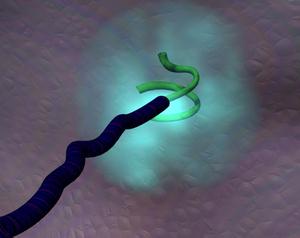
HIV TREATMENT
This is a promising place to try to stop AIDS, by helping the immune system early on in its fight against HIV. One possibility is an AIDS vaccine. Here's how it would work:
An uninfected person is exposed to a form of the virus ( ) which does not cause illness, but which does the body's defenses. The immune system is tricked into producing millions of killer T cells and antibodies custom-made to fight the virus. Some of these defenses stay in the body.

Later, if the person is infected with HIV, the immune system has a head start in its battle.
But there are problems with this approach.
So although this is a promising place in the life cycle to stop AIDS, there is still a lot of work to do before we have an effective vaccine.
To stop the virus here, we would have to keep it from ever attaching to a T cell. Let's see how this would work.
This shape on the T cell is a protein called CD4. If a lot of is given to an infected person, then HIV could attach to the decoys instead of to the T cells

The problems here are that the decoy CD4 does not remain in the body very long, and it does not attach well to HIV circulating in the bloodstream. But improved decoy CD4 might eventually be used for an intense, against a new infection
Drugs that work at this step look like the building blocks used to make DNA. But they're , so once they're used, the building process comes to a halt.
And if the virus cannot turn its RNA into DNA, it cannot hide out in the cell, and it cannot reproduce. It sounds great, but there are problems with these drugs.

HIV is , and eventually it is no longer tricked by these faulty building blocks. HIV becomes resistant to these drugs, and the life cycle continues the same as before. Another problem is that these drugs can which also need to make DNA to reproduce.
This is a good place to break the life cycle, but it's not a cure.
They're also working on a drug that would the into usable pieces. Proteins in long uncut strands are useless, and the life cycle would be broken

This is a promising place to break the life cycle, but these drugs are not a cure: they would the replication of the virus.
This is a very late stage in the life cycle of HIV. But it might eventually be a last resort for stopping AIDS. Scientists are working on ways to an AIDS patient's immune system at this step, so that when new viruses bud from infected cells, the body's defenses are strengthened and ready to fight back. There also are many drugs now available to treat opportunistic infections, which are often the cause of death in people with AIDS.
This research is promising. But this late stage of HIV's life cycle is a very difficult place to stop AIDS.